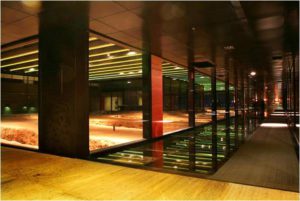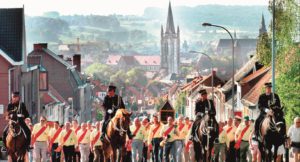UNESCO World Heritage : The beguinage of Kortrijk (Belgium)
Most beguinages were founded in the late 12th and early 13th century. They take the form of enclosed city quarters that were developed by a community of independent women. Because of their autonomous history, these gems are amongst the most well-preserved medieval parts of the Flemish cities. In 1998, thirteen Belgian beguinages were recognised as UNESCO World Heritage. The beguinage of Kortrijk is the first to develop an integral modern interpretation of the site and of the mostly little known, often ill understood, but fascinating history of these glorious women known as beguines.
This project was done on behalf of the Ename Center. 2014-2016
 E-Pang Palace Archaeological Site Park, Xi’an (China)
E-Pang Palace Archaeological Site Park, Xi’an (China)
The remains of the palace of the first emperor of China are among the biggest archaeological monuments in the world. To integrate the remains of the imperial palace of emperor Qin Shi Huang into a new city development project, the concept of an archaeological park and museum was presented before a jury of experts in Xi’an.
This project was done on behalf of the Ename Center in collaboration with Milan Kovač.
Historic Urban Landscape : Ronse (Belgium)
Cities and city development will define the economic, political and intellectual agenda in the coming decades worldwide. Because of the modern way of building, the demands for mobility, movements of migration, etc. heritage is often under threat. However, these new advancements can also be an opportunity to turn heritage into a driver for development. Our multi-annual project in Ronse is an example of how heritage can become the engine for a long-term city policy that connects issues of social development, mobility, city improvement and general well-being. The Council of Europe presented the project of Ronse as a good example of the application of the principles of the Faro Framework Convention.
This project was done on behalf of the Ename Center. 2019-2014
In-situ presentation of archaeology: The Han dynasty imperial tombs (China)
About 20 km to the north of Xi’an the Han Yang Ling museum is dedicated to the mausoleum of emperor Jing Di of the Western Han Dynasty. He ruled from 157 to 141 BC. Around the mausoleum archaeologists found 86 pits containing a complete imperial court in terracotta. Though less famous than the terracotta warriors of the first emperor of China, the several ten thousands of miniature figures and objects that surround the emperor’s resting place are therefore not less impressive. In the context of a Sino-European project funded by the European Commission, we were responsible for the aspect of how to interpret in-situ presentation of archaeological objects.
This project was done on behalf of the Ename Center.
Archaeological heritage and its interpretation: the Kemmelberg (Belgium)
The interpretation of archaeological heritage is perhaps one of the most challenging tasks in the heritage domain. For many years we coordinated an interpretation project of the Kemmelberg, one of the most important archaeological sites of Flanders. The history covers the period from the Neanderthal people to the Cold War. A fascinating period in the long history of this mountain is when it had the status of a so-called Celtic aristocratic hillfort. The vast archive of the archaeological excavations was digitised, Lidar scans were produced and a publication that covers 50 years of research was made.
Immaterial heritage defining the landscape : Fiertel Ronse (Belgium)
The recognition of immaterial heritage by UNESCO started in 2003 when the Convention for the Safeguarding of the Intangible Cultural Heritage was adopted. One of the most challenging issues is how best to safeguard this kind of heritage. Our solution is to map what people do – the intangible heritage – on the landscape – the context where the actions take place. The tool we use is a so-called Heritage Interpretation Matrix. The Fiertel of Ronse, a one day procession that has a history of at least 1000 years, is analysed by this new approach. The city council of Ronse supports the initiative to get the Fiertel recognised as UNESCO Intangible Cultural Heritage.




